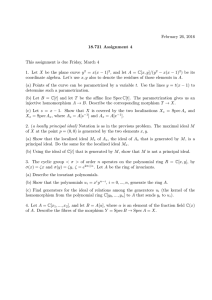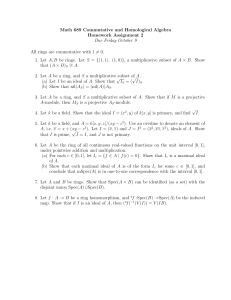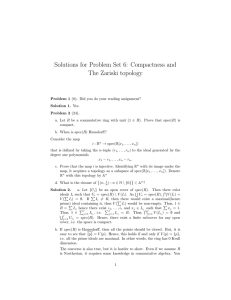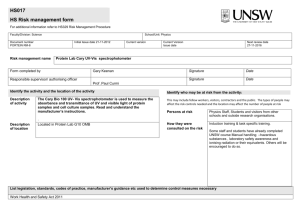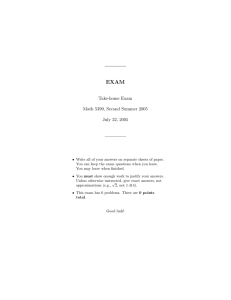TMF 1 The spectrum of the category of spectra Sebastian Thyssen
advertisement
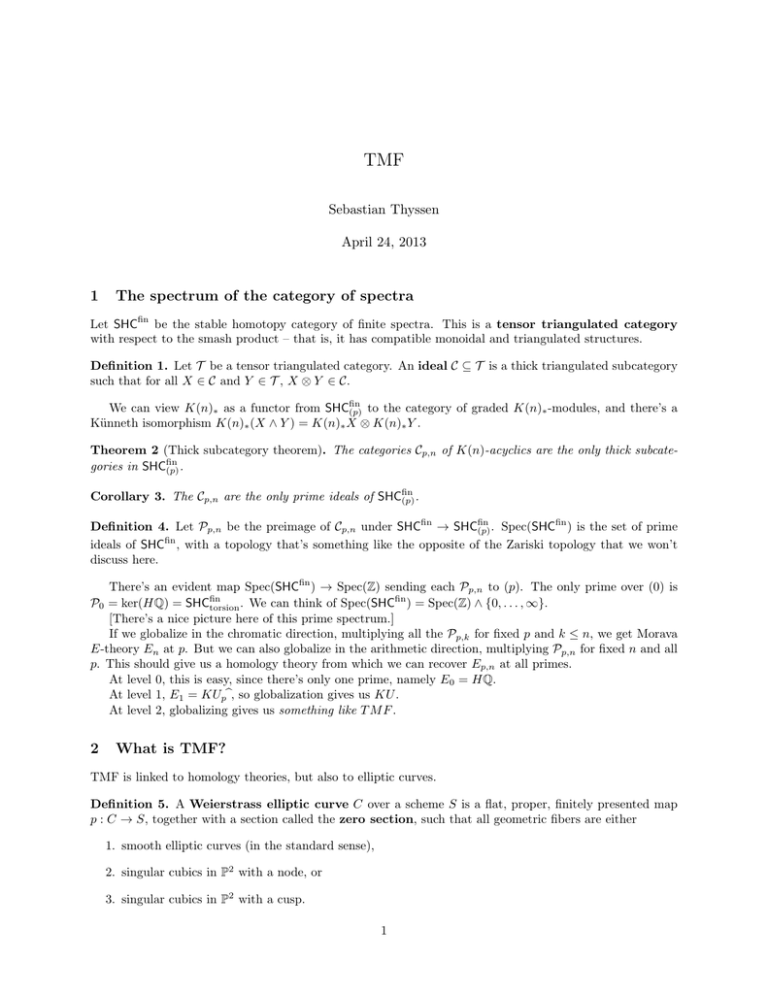
TMF
Sebastian Thyssen
April 24, 2013
1
The spectrum of the category of spectra
Let SHCfin be the stable homotopy category of finite spectra. This is a tensor triangulated category
with respect to the smash product – that is, it has compatible monoidal and triangulated structures.
Definition 1. Let T be a tensor triangulated category. An ideal C ⊆ T is a thick triangulated subcategory
such that for all X ∈ C and Y ∈ T , X ⊗ Y ∈ C.
We can view K(n)∗ as a functor from SHCfin
(p) to the category of graded K(n)∗ -modules, and there’s a
Künneth isomorphism K(n)∗ (X ∧ Y ) = K(n)∗ X ⊗ K(n)∗ Y .
Theorem 2 (Thick subcategory theorem). The categories Cp,n of K(n)-acyclics are the only thick subcategories in SHCfin
(p) .
Corollary 3. The Cp,n are the only prime ideals of SHCfin
(p) .
fin
Definition 4. Let Pp,n be the preimage of Cp,n under SHCfin → SHCfin
(p) . Spec(SHC ) is the set of prime
ideals of SHCfin , with a topology that’s something like the opposite of the Zariski topology that we won’t
discuss here.
There’s an evident map Spec(SHCfin ) → Spec(Z) sending each Pp,n to (p). The only prime over (0) is
fin
P0 = ker(HQ) = SHCfin
torsion . We can think of Spec(SHC ) = Spec(Z) ∧ {0, . . . , ∞}.
[There’s a nice picture here of this prime spectrum.]
If we globalize in the chromatic direction, multiplying all the Pp,k for fixed p and k ≤ n, we get Morava
E-theory En at p. But we can also globalize in the arithmetic direction, multiplying Pp,n for fixed n and all
p. This should give us a homology theory from which we can recover Ep,n at all primes.
At level 0, this is easy, since there’s only one prime, namely E0 = HQ.
At level 1, E1 = KUpb, so globalization gives us KU .
At level 2, globalizing gives us something like T M F .
2
What is TMF?
TMF is linked to homology theories, but also to elliptic curves.
Definition 5. A Weierstrass elliptic curve C over a scheme S is a flat, proper, finitely presented map
p : C → S, together with a section called the zero section, such that all geometric fibers are either
1. smooth elliptic curves (in the standard sense),
2. singular cubics in P2 with a node, or
3. singular cubics in P2 with a cusp.
1
2
(A more algebraic way of saying this is that the geometric fibers are given by a Weierstrass equation
y 2 z + a1 xyz + a3 yz 2 = x3 + a2 x2 z + a4 xz 2 + a6 z 3 .)
This is required to satisfy this property that ωC = p∗ Ω1C is invertible.
Example 6. Over Spec Z, there’s an elliptic curve y 2 = x3 + 2x2 + 6 with discriminant −26 · 3 · 97. We
can think of this as a curve sitting over each point of Spec Z, all of which are smooth except for those at 2
(which has a cusp) and 3 and 97 (which have nodes).
Note that elliptic curves are parametrized by A = Z[a1 , a2 , a3 , a4 , a6 ]. The only allowed transformations
of elliptic curves are those of the form [x 7→ x + r, y 7→ y + sx + t] and [x 7→ λ−2 x, y 7→ λ−3 y]. These define a
map Spec(A) × Spec(G) → Spec(A), where G = Z[λ±1 , r, s, t]. Thus if Γ = A ⊗ G, we have a Hopf algebroid
(A, Γ) which represents the groupoid of Weierstrass elliptic curves and transformations. This is MWeier , the
moduli stack of Weierstrass elliptic curves.
3
Stacks
Generally, elliptic curves over a scheme can be constructed by gluing together elliptic curves over subschemes,
and the same applies for other moduli problems. This suggests that sheaves of groupoids are generally the
right way to talk about moduli problems. To state this correctly, we have to modify the notion of ‘sheaf’
slightly, which we do by modifying the notion of ‘covering’ – this is done by introducing a new Grothendieck
topology, which is roughly an axiomatic definition of ‘open cover’ satisfying certain axioms (a pullback of
a cover is a cover, a composition of covers is a cover, . . . ). Since we’re talking about groupoids, we also need
a notion of homotopy theory, at least enough to talk about weak equivalences and homotopy limits. Then
the sheaf condition should just say that if {Ui ,→ U } is a cover, then for S to be a sheaf on U , we must have
/
Q
/Q
/ ··· .
S(U ) ' holim
/ i,j S(Ui ×U Uj )
i S(Ui )
/
This homotopy limit is called the descent datum Desc(S, U ).
Definition 7. A stack is a sheaf of groupoids.
Definition 8. Let (X0 , X1 ) be a presheaf of groupoids.
colimU Desc((X0 , X1 ), U ).
The associated stack M(X0 ,X1 ) is given by
Example 9. The stack MWeier is represented by (A, Γ). The stack Mell is represented by (A[∆−1 ], Γ[∆−1 ]),
where ∆ is the discriminant. The moduli stack MF G of formal groups is represented by (M P0 , M P∗ M P ) =
(L, W ).
Definition 10. A D-valued sheaf over a stack M on a site C is a sheaf on the site C ↓ M.
Definition 11. For f : Spec(R) → MF G , define the pullback functor
Ff∗ : Qcoh(MF G ) → Qcoh(Spec R)
by Ff∗ (S)(U ) = S(U → Spec(R) → MF G ) for U ⊆ Spec R an open subset.
Proposition 12. f is flat iff Ff∗ is exact.
Definition 13. For f : Spec(R) → MF G flat, define a homology theory E(R, G) by E(R, G)(X) =
Ff∗ M P∗ (X).
Note that M P∗ (X) will be a quasicoherent sheaf on MF G , i.e. an (L, W )-comodule, and its pullback is
a quasicoherent sheaf on Spec R, i.e. an R-module. If f factors through Spec(L), which means that we can
choose a coordinate, then this R-module will just be M P∗ (X) ⊗M P0 R.
b is
Theorem 14 (Hopkins-Miller). The map Mell → MF G sending a curve C to its formal group law C
flat.
4. DEFINING TMF
3
b : Spec(R) → MF G , and so we get a homology
Corollary 15. If C : Spec(R) → Mell is flat, then so is C
C
C
∗
theory Ell∗ given by X 7→ Ell∗ = FCb M P∗ X.
C
Definition 16. Ohom (Spec R → Mell ) is the homology theory EllC
∗.
4
Defining TMF
We’ve defined a functor Ohom from the category of étale schemes over Mell to the category of homology
theories, and we’d like to represent this by a single homology theory. Unfortunately, Mell isn’t a scheme, so
there’s no terminal object. Moreover, we can’t take colimits in the category of homology theories. However,
what we can do is lift these homology theories to honest spectra and take a colimit in the category of spectra.
Theorem 17 (Goerss-Hopkins-Miller). There exists a sheaf Otop of E∞ -rings on Mell such that π∗ Otop =
π∗ Ohom = ω ⊗∗ .
The global sections of this is the spectrum T M F .
There’s a spectral sequence with
E2s,t = H s (Mell , ω ⊗t ) ⇒ π∗ T M F.
We can do a similar thing over MWeier , giving tmf and a similar spectral sequence.
5
The homotopy of TMF
c6
c1
x + 864
, and one can check that
If 6 is invertible in R, then the Weierstrass equation simplifies to y 2 = x3 + 48
∼
there are no transformations fixing this. Thus A[1/6] = Γ[1/6] = Z[c1 , c6 ], the spectral sequence collapses at
the E1 -page, and we have
H s (Mell , ω ⊗t ) = H 0 (Mell , ω ⊗t ) = Z[c4 , c6 , ∆±1 ]/(∼).
At the prime 3, where 2 is invertible, then the Weierstrass equation becomes y 2 = x3 + b22 x2 + b44 x + b26 ,
and the transformations are of the form x 7→ x + r. Thus we get A(3) = Z(3) [b2 , b4 , b6 ] and Γ(3) = A(3) [r].
E2 is given by Z(3) [c4 , c6 , ∆, α, β]/(α2 , 3α, 3β, ∼). There is no differential on ∆3 , so we get a periodicity of
degree 72.
[A picture of the spectral sequence is shown.]
At the prime 2, similar phenomena occur. ∆8 is now a permanent cycle, giving us a 192-periodicity.
Thus, globally, T M F is 576-periodic.
As a final note, this doesn’t quite give us the thing we want at chromatic level 2, because there are
automorphisms at singular points, but it’s something close. You get closer if you put a level structure on
the elliptic curves involved.


